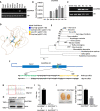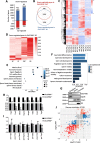Regulation of Miwi-mediated mRNA stabilization by Ck137956/Tssa is essential for male fertility
- PMID: 37069605
- PMCID: PMC10111675
- DOI: 10.1186/s12915-023-01589-z
Regulation of Miwi-mediated mRNA stabilization by Ck137956/Tssa is essential for male fertility
Abstract
Background: Sperm is formed through spermiogenesis, a highly complex process involving chromatin condensation that results in cessation of transcription. mRNAs required for spermiogenesis are transcribed at earlier stages and translated in a delayed fashion during spermatid formation. However, it remains unknown that how these repressed mRNAs are stabilized.
Results: Here we report a Miwi-interacting testis-specific and spermiogenic arrest protein, Ck137956, which we rename Tssa. Deletion of Tssa led to male sterility and absence of sperm formation. The spermiogenesis arrested at the round spermatid stage and numerous spermiogenic mRNAs were down-regulated in Tssa-/- mice. Deletion of Tssa disrupted the localization of Miwi to chromatoid body, a specialized assembly of cytoplasmic messenger ribonucleoproteins (mRNPs) foci present in germ cells. We found that Tssa interacted with Miwi in repressed mRNPs and stabilized Miwi-interacting spermiogenesis-essential mRNAs.
Conclusions: Our findings indicate that Tssa is indispensable in male fertility and has critical roles in post-transcriptional regulations by interacting with Miwi during spermiogenesis.
Keywords: Ck137956/Tssa; Male infertility; Miwi; Spermiogenesis; mRNA stability.
© 2023. The Author(s).
Conflict of interest statement
The authors declare that they have no competing interests.
Figures





Similar articles
-
Mili and Miwi target RNA repertoire reveals piRNA biogenesis and function of Miwi in spermiogenesis.Nat Struct Mol Biol. 2012 Aug;19(8):773-81. doi: 10.1038/nsmb.2347. Epub 2012 Jul 29. Nat Struct Mol Biol. 2012. PMID: 22842725 Free PMC article.
-
A Translation-Activating Function of MIWI/piRNA during Mouse Spermiogenesis.Cell. 2019 Dec 12;179(7):1566-1581.e16. doi: 10.1016/j.cell.2019.11.022. Cell. 2019. PMID: 31835033 Free PMC article.
-
miwi, a murine homolog of piwi, encodes a cytoplasmic protein essential for spermatogenesis.Dev Cell. 2002 Jun;2(6):819-30. doi: 10.1016/s1534-5807(02)00165-x. Dev Cell. 2002. PMID: 12062093
-
Noncanonical functions of PIWIL1/piRNAs in animal male germ cells and human diseases†.Biol Reprod. 2022 Jul 25;107(1):101-108. doi: 10.1093/biolre/ioac073. Biol Reprod. 2022. PMID: 35403682 Review.
-
Chromatoid Bodies in the Regulation of Spermatogenesis: Novel Role of GRTH.Cells. 2022 Feb 10;11(4):613. doi: 10.3390/cells11040613. Cells. 2022. PMID: 35203264 Free PMC article. Review.
Cited by
-
Optimization of in vivo delivery methods and their applications in seminiferous tubules of mice.BMC Biotechnol. 2025 Aug 12;25(1):83. doi: 10.1186/s12896-025-01021-0. BMC Biotechnol. 2025. PMID: 40796825 Free PMC article.
References
Publication types
MeSH terms
Substances
LinkOut - more resources
Full Text Sources
Molecular Biology Databases

